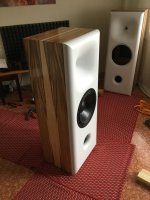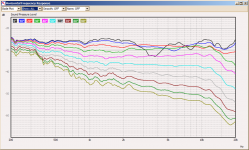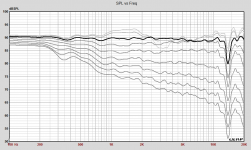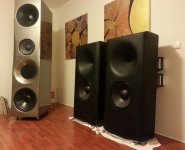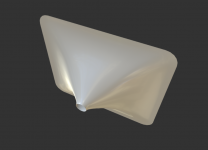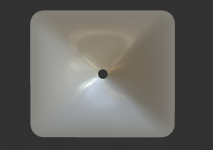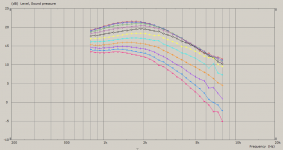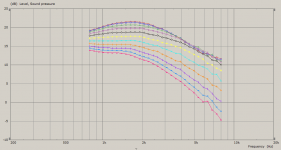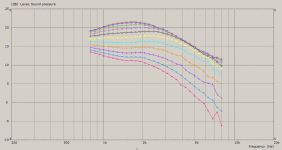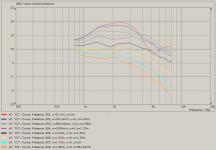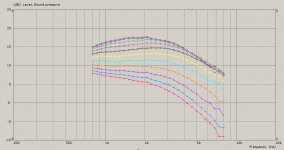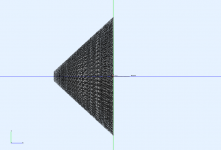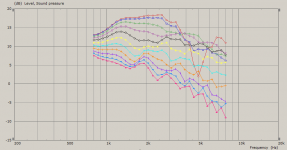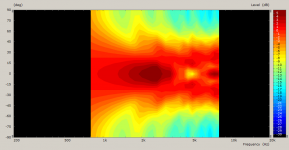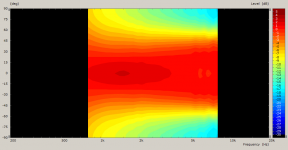Actually the "real waveguide" you commented earlier is 15.4" and I believe it will be fine. Someone may try that 🙂
It is a pity that making horns is so laborous. I still don't know how much I can believe the BEM simulations. I'd love to make all I'm able to desing but don't have the resources.
It is a pity that making horns is so laborous. I still don't know how much I can believe the BEM simulations. I'd love to make all I'm able to desing but don't have the resources.
Last edited:
Let say you have 15" or bigger waveguide. People usually mate with 15" woofer. I would prefer 3way with 8". How you would match directivity? Use two or midrange waveguide?
Or something big 1 meter like Cabase La Spehere but more like Manger Diskus.
Or something big 1 meter like Cabase La Spehere but more like Manger Diskus.
Nowadays I would go for 15 - 18" WG with 1,4" driver + 12" woofer, crossed over around 600 - 700 Hz. You may let the horn to loose the control of a beamwidth (quite smoothly), not the woofer used up to it's limits. That is the way I would go.
Last edited:
12" is doable but I'd like go extreme <300Hz xo point. Maybe something crazy with open back to second waveguide.
I have various ideas but trying to stay on the ground 🙂
Recently I discovered the Acrylic One material (AcrylicOne) which I hope will give me an opportunity to build more advanced enclosures easily. A frame covered with epoxy-filled cloth for the shape and then covered with several layers of the Acrylic. Including the horns with the help of XPS molds. That is my plan.
But I think this thread calls for something you can actually buy... I don't know of anything as good.
Recently I discovered the Acrylic One material (AcrylicOne) which I hope will give me an opportunity to build more advanced enclosures easily. A frame covered with epoxy-filled cloth for the shape and then covered with several layers of the Acrylic. Including the horns with the help of XPS molds. That is my plan.
But I think this thread calls for something you can actually buy... I don't know of anything as good.
For example, this slightly non-axisymmetric horn has dimensions of 14.7" x 13.8" (DE250). I made OS waveguides of this size before and none of them behaved so well. It may be that I gave up too early - the termination is really critical which I have realized only recently. Do you think you could design OS WG of this size to perform better?
Is this waveguide perfectly axisymmetric? If not then why not?
Yes, termination is critical, but so is the flare near the throat. If this goes from round to any other shape then there will be problems, especially across the diagonals (which no one seems to ever look at.)
Let say you have 15" or bigger waveguide. People usually mate with 15" woofer. I would prefer 3way with 8". How you would match directivity?
You can't really, that's why I use the 15". The 8" will always be wider than the waveguide unless you cross very high up, which is not ideal as the polar errors grow as the frequency goes up. Sorry, but 15" really is the better choice - lower crossover, less lobing, better match.
Nowadays I would go for 15 - 18" WG with 1,4" driver + 12" woofer, crossed over around 600 - 700 Hz. You may let the horn to loose the control of a beamwidth (quite smoothly), not the woofer used up to it's limits. That is the way I would go.
Having done all these designs, I can tell you that 15" works best. 12" is workable, but a 1.4" driver is unnecessary and will struggle with the last octave that a 1" driver can do. And you won;'t be able to get the cross down to 700 Hz and have the woofer and waveguide polars match. It will have to be about 900-1100 for that to happen. A 15" can get down to 700-800 Hz (the NS-15 does that.)
Last edited:
It is not and the reason why is that I felt that disrupting the exact symmetry might be a good thing. It turned out exceptionally well but unfortunately two things were made at the same time: non-axisymmetric shape and a more gradual termination. Would an axisymmetric one of a similar size be as good? Who knows. That is why I asked if you think it could be done, because I haven't seen it yet.Is this waveguide perfectly axisymmetric? If not then why not?
Yes, termination is critical, but so is the flare near the throat. If this goes from round to any other shape then there will be problems, especially across the diagonals (which no one seems to ever look at.)
All these horns I presented are so made that the first ~1/5 of the depth is exactly axisymmetric OS. Then they gradually change into another shape, whatever it is (can be anything).
The loudspeaker below is a 12" woofer with the 14x13" horn I already presented.
Attachments
These are some loudspeakers based on your work I've made in the past 🙂worship🙂. The waveguides are about 18" OS. The black box with a 15" woofer, the huge one (the crazy huge one) has 12" midrange and 1,4" driver. The beamwidth gets wider below about 1 kHz anyway. The only difference is whether the woofer or the waveguide does it. I'm willing to sacrifice the last octave in exchange of lower crossover point with a bigger driver anytime. This was 18Sound ND1460A, which has this hole at about 13 kHz but these days quite good 1,4" drivers can be found (18Sound ND3T for one example), IMHO.Having done all these designs, I can tell you that 15" works best. 12" is workable, but a 1.4" driver is unnecessary and will struggle with the last octave that a 1" driver can do. And you won;'t be able to get the cross down to 700 Hz and have the woofer and waveguide polars match. It will have to be about 900-1100 for that to happen. A 15" can get down to 700-800 Hz (the NS-15 does that.)
BTW, thanks again Earl for the time spent explaning here. I tried to listen and I'm glad I did.
Attachments
Last edited:
Regarding the diagonals. I made some infinite baffle simulations with ABEC for the rectangular horn and it didn't seem to be so bad (see the filenames). I would be happy with that. But that was just a quick exercise.
Attachments
And finally, a good and not so good wavegiude...
(The occasional wiggle above 6 kHz in these charts are some artefacts of the calculation. Later on I figured out how to get rid of them but these are quite old pictures.)
(The occasional wiggle above 6 kHz in these charts are some artefacts of the calculation. Later on I figured out how to get rid of them but these are quite old pictures.)
Attachments
Last edited:
So that last rapid mouth flare causing the differences ?
I prefer to cover that last flare change with thick foam (in my avatar).
I suppose a conical would work for me (with rounding at throat ideally like os).
I prefer to cover that last flare change with thick foam (in my avatar).
I suppose a conical would work for me (with rounding at throat ideally like os).
Last edited:
It must be because it is the only difference between the two. At least this is what I've learned from the simulations.
It is not and the reason why is that I felt that disrupting the exact symmetry might be a good thing. It turned out exceptionally well but unfortunately two things were made at the same time: non-axisymmetric shape and a more gradual termination. Would an axisymmetric one of a similar size be as good? Who knows. That is why I asked if you think it could be done, because I haven't seen it yet.
I do believe that the biggest positive effect was the large termination flare. Less would be the squaring disruption.
I don't understand what you mean by "That is why I asked if you think it could be done, because I haven't seen it yet." I've made hundreds of waveguides that size that are perfectly axisymmetric.
And I have done exactly what you did squared the mouth. My results were not conclusive. There were some issues that improved, but some new ones got worse. Hence, to me it wasn't clear that "disruption" (and I understand why you think that might be a good thing) is the right way to go.
Marcel, those are some very impressive builds. I too have made waveguides a la OSWG in similar sizes, but mine were much less polished than what I'm seeing here.
These are actually builds by my friends, I only either sketched the horns or made the electro-acoustical work. I'm still working on mine. To be honest, I probably wouldn't use pure OS waveguide again as my algorithm for non-axisymmetric shapes seems to work exceptionally well, even for moderately sized horns. You really have to add quite large termination flare to OSWG to behave as smoothly. At least this is what I have found out.
- Home
- Loudspeakers
- Multi-Way
- 1.4" or 2" throat large constant directivity horns you can actually buy!
